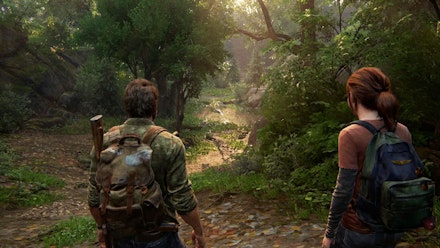Platforms: PS5
Almost a decade on from its original release, The Last of Us retains its reputation as one of the finest games of all time. A post-apocalyptic epic, the journey of Joel and his ward Ellie across a plague-ravaged USA showed just how emotionally engaging video games as an art form can be – between shootouts with rage-fuelled fungus zombies and treacherous human survivors, of course – and there's even a TV series adaptation on the way. Even back in 2013, it pushed technical and creative limits, bringing cinema-quality performance capture to the humble PS3 and winning awards for everything from its writing to art design at every turn.

Shortly after, a remastered edition followed for PS4, elevating the already stunning game into the realms of true HD, with a 60fps performance boost to boot. This presents developer Naughty Dog with a conundrum – with a still-gorgeous version readily available, how can it make yet another release of the game a compelling proposition for players? The clue is in the name of this latest return for Joel and Ellie – The Last of Us Part I isn't just another remaster, it's a ground-up remake intended to bring the original into line with its 2020 sequel The Last of Us Part II.
In some ways, this leapfrogs its successor. Part II was originally released on PS4, with better performance on PS4 Pro and a PS5 patch giving it an after-the-fact upgrade, while Part I has been made for PS5 natively, allowing it to make use of the more powerful console’s capabilities from the start. As a result, every scene is more detailed, boasting phenomenal lighting, a greater density of objects making environments feel more realistic, far better textures, and more destructibility.
There’s a great showcase of this early on, during the still-heartbreaking prologue at the beginning of the outbreak, where Joel and family drive past a burning barn. In the earlier releases, it was a static model; now, it’s a gloriously detailed pyre, with support beams and walls crumbling and collapsing as the fire rages. Elsewhere, the enhanced model details and richer shadow depth makes the overgrown ruins of fallen America feel even more realistic, almost as if the vines and weeds are growing out of your TV. Does such visual showmanship impact the gameplay? No. Does it make The Last of Us Part I even more absorbing, pulling players further into its horrifying reality? Absolutely.
In other ways though, the game still suffers some restrictions. Despite offering true 4K visuals with its ‘fidelity’ mode, the frame rate is capped at a relatively meagre 40fps. ‘Performance’ mode offers higher frame rates, up to 60fps, but only delivers ‘dynamic 4K’ (which reduces resolution on the fly to maintain performance) or 1440p resolution. A seeming shift in art direction, favouring the darker, muted hues of Part II, is a change of debatable merit, creating better consistency across the duology but definitely altering the feel of Part I in places for returning players.

For all the environmental improvements – and they are undeniably improvements, bordering on photo-real in places - character models don’t get quite the same glow-up. While characters and monsters are more detailed than ever, almost bridging the uncanny valley, they also often look distinctly different. Joel is visibly more haggard and worn from his experiences, while Ellie sometimes appears considerably older than her 14 years, almost in line with her older Part II incarnation. As with the new art direction, these changes aren’t necessarily bad, but they can be jarring at times if you’re familiar with the tone and aesthetic of the earlier versions.
The changes for Part I go beyond the visual though, with the remake taking impressive advantage of PS5 hardware features. 3D audio – particularly through headsets such as Sony's Pulse – is phenomenally immersive, with incredible levels of directionality. Bullets sound as if they whizz right past the ear, while the unnerving chittering of the infected practically stalks you through the game. It's the haptics that really impress though – the DualSense controller feels alive in your hand, with a spatial approach to rumble that further grounds you in Joel and Ellie's grim world. A truck rolling past on your (in-game) left will generate stronger vibration in your left hand, radiating softly across the controller to the right. Explosions ripple through your grip, and the adaptive triggers kick in for appropriate levels of resistance when drawing a bowstring or even applying a bandage. Short of VR (a natural for PSVR2, no?), it's as close to being in the game as you're likely to get.
From colour blindness filters to full screen reader support, whole new communities are catered for – a very welcome effort for inclusion, and one that more developers should make.
Naughty Dog has also included a host of brilliant accessibility features that make The Last of Us Part I more approachable for players with disabilities. From colour blindness filters to full screen reader support, whole new communities are catered for – a very welcome effort for inclusion, and one that more developers should make.
But of these many and varied overhauls, do any actually impact the game itself? Only a few. Better enemy AI is perhaps the most material change, making encounters more tense and tactical, emphasising use of stealth mechanics to take out enemies silently or avoiding combat entirely. Elsewhere, some elements of the controls are updated, made more contemporary, but nothing that differs significantly enough to stand out. Naughty Dog has also included a few new play options – a speedrun mode available after completing the game once, and an interesting approach to a permadeath difficulty setting, which will wipe out progress for the most recent act, chapter, or even entire game upon dying, depending on how masochistic players are feeling. Aside from that, The Last of Us Part I is the same great game – with the Left Behind prequel included, and playable from the start – that made waves back in 2013.
Naughty Dog’s biggest obstacle with making a case for The Last of Us Part I is ultimately its own brilliant work on the original, and especially the PS4 remaster. The latter in particular still looks great even now – certainly “good enough” for many players, especially those without a 4K screen – which makes it hard to justify this £70 remake. Even having been rebuilt from the ground up, that’s a bitter pill to swallow.
Make no mistake – as a game in and of itself, The Last of Us is still a five-star, must-play experience. It holds up on every narrative and creative front – if anything, exploring a world ravaged by an unstoppable disease hits harder in 2022, after living through a real-world pandemic – and if you have a 4K screen, this is undeniably the version to get. It should rightly stand as the definitive incarnation of The Last of Us going forward. However, for returning players, the cost-benefit analysis makes this far from an essential upgrade.
